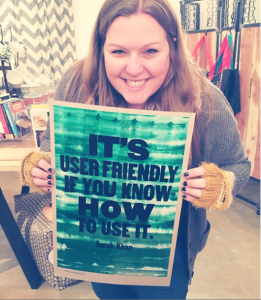Today I woke up to a text message from my sister that said “Classrooms of the Future on Today Show! Textbooks to Tablets!” I replied with “Awesome! But it should really be called ‘Classrooms of Today’!” and she replied with an affirming “Yes!” She lives on a farm in Iowa. Her husband, my brother in law, works for John Deer and is using technology everyday to help farmers in his area create “smart farms” with mobile technology. It’s amazing. Google it. We do completely different work but are able to vibe out on topics related to mobile technology because he gets it, and so does she. Not only that. They are parents to 3 children under the age of 5 that are mobile natives, meaning they were born in the age of mobile technology. Ben is going to start kindergarten next year and he can teach himself how to do things on a Kindle Fire that it would take my Dad weeks to learn. (Sorry, Dad…but you know it’s true!) They learn differently because they were born into a different world. This issue matters. Society (teachers and Today Show watchers alike) need to understand that mobile technology and the issue of how to best support mobile natives in the classroom matters. A lot.
Understanding the issues we are facing in education is critical to our society’s progress, but they tend to be so complex that they are difficult to pinpoint and address. More and more it seems like everyone has an opinion about what is wrong with our education system but much less to say about how to effectively (and realistically) fix it. Regardless of the multitudes of expectations and complex circumstances educators are dealing with we are all being challenged with the task of helping shape and prepare students to thrive in an ever-changing, globally connected world. Furthermore, our young learners are developing a moral code and a learning style that are different from pre-internet and pre- mobile technology learners. Most teachers (and people born before the late ’80s) are struggling to connect with these developments and how they are not going to, but rather are already, deeply effecting the way we teach, learn, and live.
Research speculates that 65% of the careers our students will have do not even exist yet. This phenomenon is one of the truest challenges the field of education has ever had to face. Furthermore, the role of teacher is morphing quickly because, for the first time in human history, our youth can have access to unlimited information, resources, and connections. This access could help them transcend virtually any circumstance, but only if we, as educators, work together to provide this access and to create the space our students need to become lifelong learners capable of adapting. And it will only work if we are open enough to see the real needs of a modern learner and the true expectations and capabilities of the modern educator.
This brings me to what I believe is one of the most critical trends—the one that must be addressed and accepted across the board to create real support and solution for learners of today: partnerships. As teachers, we are no longer the primary source of information. Even harder to swallow for many educators, a textbook is no longer the principal source of the information necessary to learn, adapt, and succeed.
Teachers are resources. Textbooks are resources. But nothing can compete with the global bank of knowledge and connectivity that the Internet provides. Knowledge learned can be immediately explored, adapted, shared, and re-created. Our students already do this—they already learn this way. They are digital natives, born and raised. But when they come to learn in our classrooms, we pretend that they are not. We ask them to perform an impossible task: we ask them to be someone else.
They are builders. They are content creators. They are native synthesizers. And they are bored. To fix this boredom, this disconnect, the only option for us is to become partners with them. We must partner to explore real goals, ethical behavior, self-assessment, and productive communication. We must partner with them so that they can learn to create, to tinker, and to find their own voices. We must allow them to use their tools to create solutions to problems of their world. We must work against homogenization so that they can walk confidently into their next phase of life. Right now, they are leaving timid and unsure of their compatibility with our world. I teach high school. I see it everyday. I hope I won’t be writing this same blog when my nephew is starting high school.
If we walk with them to learn in their way, then they will not feel alone as they walk away from us. If we work with them to create empathetic connections to all humans, then they will never feel disconnected from our world or even from a world that does not exist yet. We must embed our content into the problems we are solving in the classroom. We must use our common core strands to guide projects and to inspire in-depth usage of that core to solve problems of the world, not fill in bubbles. We must activate passions and we must side-step who we formerly were. We might even take a step back. Yes, a step back is what we need; to truly partner, we must consider ourselves learners too. When we all begin to truly utilize the partnership approach in every school and in every classroom, we will see the change needed to support our students at the most critical level and all of us will be much better off because of it.
